




Key Formulas and Tricks to Solve Surface Area Questions
Three-dimensional shapes' surface area is one of their most essential characteristics. The surface area of a shape is a topic that comes up frequently in geometry. Using a general formula for surface area, it is possible to solve the objects having simple shapes and forms. We will need to use our understanding of one or more 2-dimensional shapes to handle more challenging shapes.
In this article, we will find the surface area of cube and cuboid as well as cylinder. Moreover, we will determine the formula of total surface area of cuboid, cube and cylinder. We can readily determine their surface area and volume using the established equations. Have you ever considered what may happen if these fundamental shapes combined to create a new shape? How will we determine the new shape's capacity then? This is explained in the article that follows.
Surface Area Definition
Any solid shape's surface area is equal to the sum of all of its faces' respective areas. For instance, we add the areas of each of the rectangles that make up a cuboid to determine its surface area. When calculating the surface area of complex shapes, the combined area of all the surfaces of the shapes that make up a complex structure is calculated.
There are Primarily Two Categories of Areas:
Total Surface Area
Curved Surface Area/Lateral Surface Area
Total Surface Area
The total surface area is the area that includes the base(s) and the curving portion. It is the overall area that the object's surface occupies. If the shape has a curved base and surface, the total area will be equal to the sum of the two areas.
Curved Surface Area/Lateral Surface Area
The area of just the curved part of the shape, excluding its base(s), is referred to as the curved surface area. For shapes like a cylinder, it is sometimes referred to as the lateral surface area.
The Below Table shows the Surface Area of the Various Shaped Objects:
Surface Area of Cuboid Formula
Total Surface Area of Cuboid : The surface areas of each of the six sides can be added up to determine their total area. Due to the fact that a cuboid's faces are all rectangles, the total surface area of the cuboid is determined by adding the areas of each rectangle on each face. With the guidance of the following figure, let's understand this better.
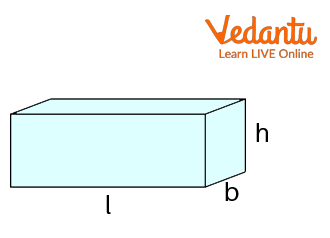
A Cuboid
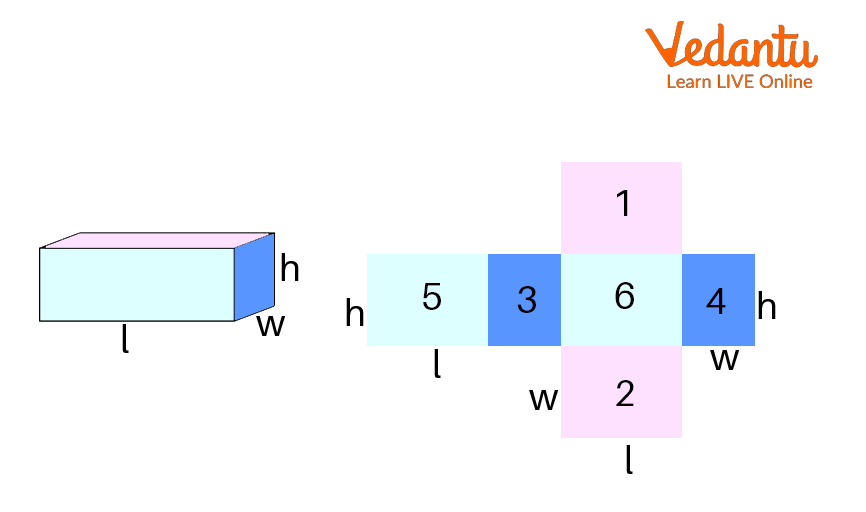
Cuboid with Different Faces
According to the figure above, all of the faces are numbered $1$, $2$, $3$, $4$, $5$ and $6$. In other words, we get this figure if we visualise the cuboid as a two-dimensional net.
Area of rectangles $1$ and $2$: This refers to the area of the rectangle with the top and bottom faces equal to $l \times w$. As a result, $lw + lw = 2lw$.
Area of rectangles $3$ and $4$: This refers to the area of the rectangle that comprises the front and back faces and has the dimensions $h \times w$. As a result, it is, $hw + hw = 2hw$ .
Area of rectangles $5$ and $6$: This refers to the area of the rectangle formed by the faces on the left and right sides, which is equal to $l \times h$. As a result, $lh + lh = 2lh$ .
The surface area of the six faces is, therefore, equal to $2lw + 2hw + 2lh$. So, a cuboid with $l$, $w$, and $h$ dimensions will have a total surface area of $2(lw + hw + lh)$ .
Lateral Surface Area of Cuboid : The total surface area of a cuboid's four vertical sides makes up its lateral surface area of the cuboid. If the top and bottom faces are taken out of the above figure, the lateral surface area of the cuboid will be identified. The cuboid's lateral surface area is
Total Surface Area $ - $ Area of Top and Bottom Faces $ = $ Lateral Surface Area
Lateral Surface Area $ = 2(lw + hw + lh) - 2(lw)$
$ = 2lw + 2hw + 2lh - 2lw$
$ = 2hw + 2lh$
$ = 2h(l + w)$
Surface Area of Cube Formula
Total Surface Area of Cube :To determine the area filled by the six surfaces, use the cube's total surface area formula. The cube's total surface area is calculated by multiplying the square of the side length by six. As a result, the formula for the cube's surface area with side length "$a$" is "$6{a^2}$".
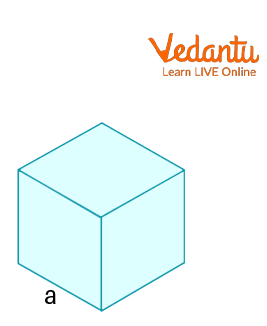
A Cube
Lateral Surface Area of Cube : The area occupied by the $4$ lateral or side surfaces of the cube is calculated using the cube's lateral surface area formula. The cube's lateral surface area is determined by multiplying its side length’s square by $4$. Therefore, "$4{a^2}$" is the formula for the cube's lateral surface area with side length "$a$".
Surface Area of Cylinder Formula
Curved/Lateral Surface Area of Cylinder : A cylinder's curved surface area is the area that is entirely covered by its curved surface. The curved surface area of a cylinder is estimated using the formula below if the height of the cylinder is $h$ and the radius of the base is $r$:
Lateral surface area of cylinder $ = 2\pi rh$
Total Surface Area of Cylinder : The area of the two bases as well as the area of the curved surface are added to determine the cylinder's total surface area. Consequently, the following is the formula for the cylinder's total surface area:
Area of the two bases$ + $Area of the curved surface$ = $Cylinder's total surface area.
Due to the cylinder's circular bases, their total area will be equal to $\pi {r^2} + \pi {r^2}$ . We also know that a cylinder's curved surface area is $2\pi rh$.
The cylinder's total surface area is $(\pi {r^2} + \pi {r^2}) + 2\pi rh$ .
Cylinder's total surface area is equal to $2\pi r(r + h)$ .
Formulation for the Surface Area of a Cylinder : Any shape's area is the space it occupies. A cylinder has a curving surface that unfolds into a rectangle and two flat surfaces that are both circulars. Look at the cylinder with the provided height ("$h$") and radius ("$r$"). To further understand this, let's open a 2-dimensional cylinder.
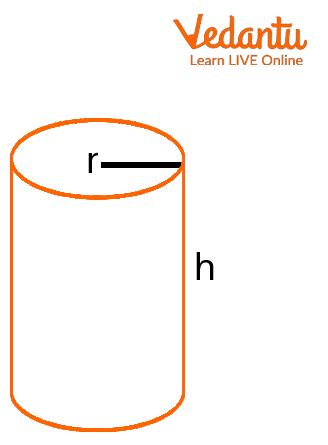
Cylinder
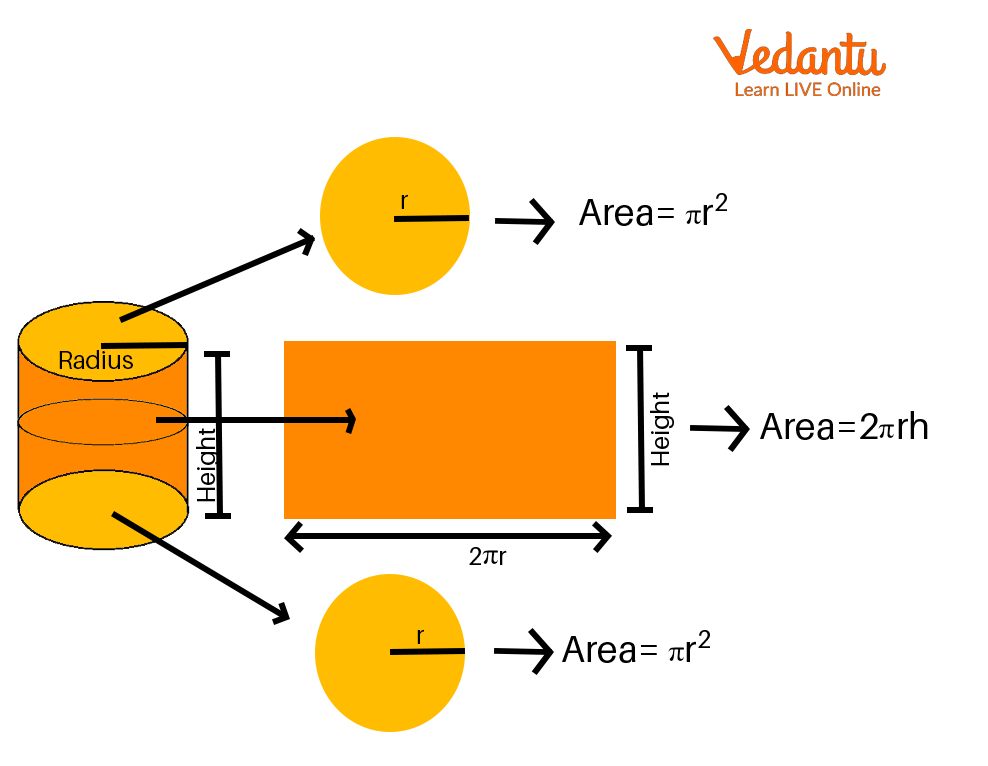
Cylinder Expanded in the Shape of a Rectangle
Look at the figure above, where the two bases are circles and the area of the curved surface expands up as a rectangle.
The area of the two curves is now $(\pi {r^2} + \pi {r^2})$ , where $r$ is the base radius.
One side of the rectangle corresponds to the cylinder's height, $h$, and its length, $2\pi r$, to the circle's diameter.
The area of this rectangle $(l \times b)$ is, therefore, equal to $2\pi r \times h$, which is also the cylinder's curved surface area.
As a result, the cylinder's total surface area is equal to $2\pi {r^2} + 2\pi rh$ , or $2\pi r(r + h)$ .
Solved Examples
Q.1. Determine the total surface area of a cubic construction whose sidewalls are $7$ metres long.
Solution: Given that the sidewall's length is $7$ metres.
Using the formula, we are aware that
Total Surface Area is $6{a^2}$.
Total Surface Area \[ = 6 \times 7 \times 7 = 294\] sq. m.
Q.2. Determine the surface area of a cylindrical tank with a radius of $4$ yards and a height of $8$ yards using the cylinder's surface area formula. What will the overall cost of the painting be if the cylindrical tank painting costs \[\$ 6\] per square yard?
Solution: We are aware that the formula for a cylinder's total surface area is:
Total Surface Area $ = $ Curved Surface Area + Area of Top and Bottom Faces
\[ = 2\pi rh + 2\pi {r^2} = 2\pi r\left( {r + h} \right) = 2 \times \dfrac{{22}}{7} \times 4\left( {4 + 8} \right) = 301.68\] square yards.
Painting costs come out to \[301.68 \times \$ 6\] per square yard, or \[\$ 1810.08\] .
The cost of the artwork is \[\$ 1810.08\] .
Q.3. Determine the cuboid's total surface area and lateral surface area. Its dimensions are $6$ inches long, $4$ inches wide, and $3$ inches high.
Solution: As is general information, a cuboid's total surface area is equal to \[2\left( {lb + bh + lh} \right)\]and its lateral surface area is equal to $2h(l + b)$.
Here, the dimensions are $6$ inches long, $4$ inches wide, and $3$ inches tall.
Total surface area of the cuboid is equal to \[2\left( {lb + bh + lh} \right) = 2{\text{ }}\left[ {\left( {6 \times 4} \right) + \left( {4 \times 3} \right) + \left( {6 \times 3} \right)} \right]\] sq. inches
Cuboid's total surface area $ = 108$ sq. inches.
Cuboid's lateral surface area is equal to \[2h\left( {l + w} \right) = 2 \times 3\left( {6 + 4} \right)\] sq. inches and is therefore equal to \[60\] sq. inches.
As a result, the cuboid's lateral surface area is \[60\] sq. inches and its total surface area is $108$ sq. inches.
Practice Questions
1. Obtain the surface area of the cube where the edge is $4$ inches using the cube's surface area formula.
2. Identify the total surface area of a cylindrical container with a \[28\] cm diameter and a $15$ cm height.
Answers
1. $96$ sq. inches
2. \[2552\] sq. cm
Summary
The surface area of an object is the total area occupied by all of its surfaces. Two categories—Curved Surface Area (CSA) and Lateral Surface Area (LSA), respectively—are used to categorise the surface's area (TSA). The term "curved surface area," also referred to as "lateral surface area," refers to the surface area of a surface which is curved in shape. The bottom and top sections, as well as the lateral surface area, make up the overall surface area. The three-dimensional shapes' surface areas are included in this article. It greatly facilitates the speedy resolution of issues based on it.
FAQs on Surface Area Made Easy: Cube, Cuboid, and Cylinder
1. What are the formulas for the surface area of a cube, cuboid, and a right circular cylinder?
The surface area formulas for these fundamental 3D shapes are as follows:
- Cube: If the side length is 'a', the Total Surface Area (TSA) is 6a² and the Lateral Surface Area (LSA) is 4a².
- Cuboid: For length 'l', breadth 'b', and height 'h', the Total Surface Area (TSA) is 2(lb + bh + hl) and the Lateral Surface Area (LSA) is 2h(l + b).
- Cylinder: For radius 'r' and height 'h', the Curved Surface Area (CSA) is 2πrh and the Total Surface Area (TSA) is 2πr(r + h).
2. What is the main difference between Total Surface Area (TSA) and Lateral Surface Area (LSA)?
The key difference lies in which faces of the solid are included in the calculation. The Lateral Surface Area (LSA) or Curved Surface Area (CSA) is the area of only the sides of a 3D object, excluding its top and bottom bases. For example, it's the area of the four walls of a room. In contrast, the Total Surface Area (TSA) is the sum of all its surfaces, including the LSA and the area of the top and bottom bases. For a room, this would be the area of the four walls plus the area of the ceiling and the floor.
3. How does the concept of surface area differ from volume?
Surface area and volume measure two different properties of a 3D object. Surface area is a two-dimensional measurement (expressed in square units like cm²) that quantifies the total area of the object's outer surfaces. Think of it as the amount of wrapping paper needed to cover a box. Volume, on the other hand, is a three-dimensional measurement (expressed in cubic units like cm³) that quantifies the amount of space the object occupies. It represents the box's capacity to hold something inside.
4. Why is the total surface area of a cube calculated as 6a², and its lateral surface area as 4a²?
This is because a cube is composed of six identical square faces. The area of a single square face with side length 'a' is a².
- The Total Surface Area (TSA) is the sum of the areas of all six faces. Therefore, TSA = a² + a² + a² + a² + a² + a² = 6a².
- The Lateral Surface Area (LSA) includes only the four side faces, excluding the top and bottom faces. Therefore, LSA = a² + a² + a² + a² = 4a².
5. Can you provide some real-world examples where calculating surface area is important?
Yes, calculating surface area has many practical applications in daily life. For instance:
- Painting and Plastering: To determine the amount of paint or plaster needed to cover the walls (LSA) and ceiling of a room.
- Packaging: To calculate the amount of material (like cardboard or plastic) required to manufacture a box or a wrapper, which directly impacts cost.
- Gift Wrapping: To find out how much wrapping paper is needed to cover a present completely (TSA).
- Manufacturing: To calculate the cost of coating or plating an object, or to design heat sinks in electronics where a larger surface area helps dissipate heat more effectively.
6. In what practical situation would you need to calculate only the Curved Surface Area (CSA) of a cylinder and not its Total Surface Area?
You would calculate only the Curved Surface Area (CSA) when you are interested in the area of the vertical, curved part of the cylinder, excluding its flat circular top and bottom. A common example is calculating the area for a paper label on a cylindrical tin can. The label only wraps around the curved body of the can. Another example is finding the cost of painting the external surface of cylindrical pillars or pipes, where the top and bottom are not accessible or do not require painting.
7. How is the surface area of a composite solid (like a cylinder attached to a cuboid) calculated?
To find the surface area of a composite solid, you must sum the areas of all exposed surfaces only. The key is to identify and subtract the areas of the faces that are joined together and are therefore not part of the exterior surface. For example, if a cylinder is placed on top of a cuboid, you would calculate:
- The LSA of the cuboid.
- The area of the cuboid's top face, minus the area of the circle where the cylinder rests.
- The CSA of the cylinder.
- The area of the cylinder's top circular face.








































